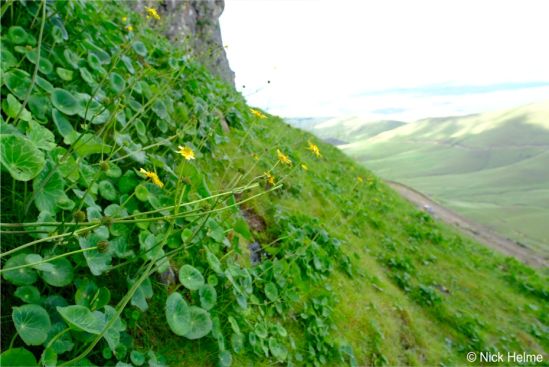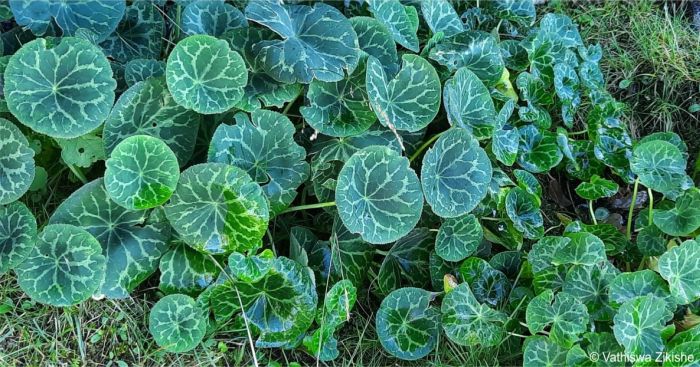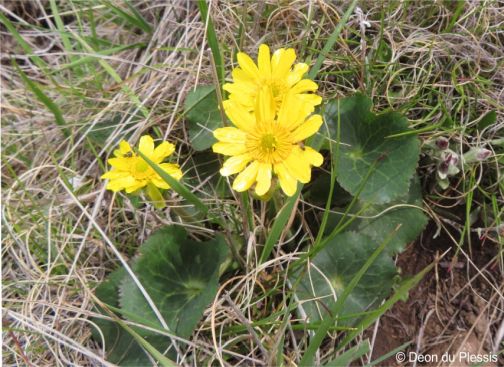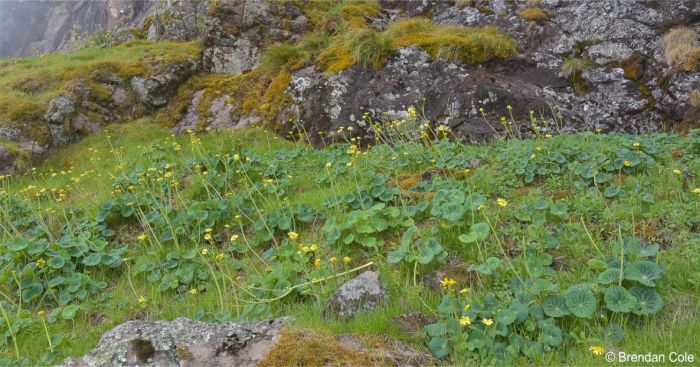Peltocalathos baurii
Peltocalathos baurii (MacOwan) Tamura
Family: Ranunculaceae
Common names: Drakensberg buttercup, nasturtium-leaved buttercup, large-leaved ranunculus (Eng.); qojoana (seSotho)
Introduction
A rarely seen South African relative of the buttercup from high in the Drakensberg Mountains, with rounded fleshy leaves and bright yellow flowers in spring and summer.

Description
Description
Peltocalathos baurii is a cluster-forming rhizomatous perennial herb about 600 mm tall. The roots are fleshy and without a taproot. Its stem is covered with brown old leaf sheaths. The leaves are orbicular, with a leaf stalk (petiole) about 300 mm long that attaches in the centre of the blade, underneath the leaf (peltate) and is hollow. The leaves are large, about 30–200 mm in diameter, leathery, dull dark green with white, visible veins on the upper (adaxial) surface. The margins are reddish with evenly spaced, small, blunt teeth. The flowers are solitary or on a branched stalk (peduncle), about 2 or 3 times as long as the leaves. Peltocalathos baurii flowers are bright yellow, 10–25 mm in diameter, with 12-15 narrow petals, bright and shiny on the upper surface but dull and paler underneath, in spring and early summer (from October to December). The fruit is a longitudinally wrinkled, broadly elipsoid achene.

Conservation Status
Status
According to the Red List of South African plants, the conservation status of Peltocalathos baurii is Least Concern (LC). This means that the plant population is stable in the wild and it is currently at low risk of extinction.
Distribution and habitat
Distribution description
Peltocalathos baurii occurs only in grassland and on forest margins, usually in wet places such as damp gullies, at the base of cliffs, near streams, swamps and waterfalls. It is endemic to the southern African Drakensberg Mountains, ranging from the Katberg in the Eastern Cape through KwaZulu-Natal, Lesotho, Eswatini and Mpumalanga to Limpopo. It grows at an elevation of 1 000-3 000 m.

Derivation of name and historical aspects
History
Ranunculaceae is a large plant family that is distributed worldwide. The family is considered one of the basal families of the eudicots. Members of the Ranunculaceae family show a wide variation in morphological characters, particularly in their fruits and floral arrangement. The family was divided into three subfamilies and eleven tribes by Tamaru in 1995. This classification was done based on the fruit type, carpel and chromosome number.
This plant was formerly called Ranunculus baurii and underwent a taxonomic reclassification and it is now known as Peltocalathos baurii. This reclassification was primarily based on a comprehensive taxonomic review in 1992 by Michio Tamura who first described Peltocalathos as a monotypic genus on the basis of its peltate leaves and longitudinally veined and ribbed achenes, which distinguish it from other Ranunculus species. Tamura (1927–2007) was a distinguished botanist and researcher and was known for his extensive work on the taxonomy and phylogeny of the Ranunculaceae.
The genus name Ranunculus means ‘small frog’ in Latin and refers to the wetland or running stream habitat that frogs and these plants typically inhabit. The genus name Peltocalathos is derived from the Greek words pelte meaning ‘shield’ and kalathos meaning ‘basket’ or ‘cup’, which might be in reference to the shape of the leaves and flowers. The species name baurii is in honour of Rev. Leopold Baur (1825–1889) who was a missionary and noted botanist and naturalist associated with the discovery and collection of the species.

Ecology
Ecology
The petals of Peltocalathos baurii are narrowed at the base into short claw with a nectar-secreting pit. The nectar serves to attract pollinators such as butterflies, birds and insects, which facilitates pollination. Plants that are growing in sheltered areas tend to be larger than those growing in shallow soils and more exposed areas. Peltocalathos baurii enjoys growing in full sun or where it receives at least 4 hours of sunlight each day and needs ample water.

Uses
Use
An excellent ornamental plant or groundcover to attract attention in marginal aquatic areas, or beside streams or water features. Plants in the genus Ranunculus are known to contain toxic compounds, but no toxicity or medicinal uses have been recorded or published under Peltocalathos baurii.

Growing Peltocalathos baurii
Grow
Peltocalathos baurii can be propagated by sowing seeds in well drained seedling mix. The seeds do not require any treatment. The soil must be kept moist until they germinate. It will take 10-30 days for seeds to germinate at a temperature of 18°C to 20°C. It can also be propagated by dividing the tubers.
Peltocalathos baurii must be watered regularly, especially during the growing season (spring and summer). The soil must be consistently moist but not waterlogged. It thrives in a location that is more sunny with partial shade.
References
- Brendan Cole 2018. Observation of Peltocalathos baurii, Naude's Neck Pass, Eastern Cape. Inaturalist. Online. https://www.inaturalist.org/observations/18899036.
- Clarke, H. & Charters, M. 2016. The illustrated dictionary of southern African plant names. Flora & Fauna Publications Trust, Jacana, Johannesburg.
- Compton, R.H. 1976. The Flora of Swaziland. Journal of South African Botany, Supplementary Volume No 11.
- Du Plessis, D. 2023. Observation of Peltocalathos baurii, Pelion Peak, Lady Grey, Eastern Cape. Inaturalist. Online. https://www.inaturalist.org/observations/192363352.
- Kumar, J.U.S., Chaitanya M.J.K., Semotiuk, A.J. & Krishna, V. 2019. Indigenous knowledge of medicinal plants used by ethnic communities of South India. Journal of Ethnobotany Research and Applications 18:1–112.
- Emadzade, K., Lehnebach, C., Lockhart, P. & Hörandl, E. 2010. A molecular phylogeny, morphology and classification of genera of Ranunculeae (Ranunculaceae). Taxon 59(3):809-828.
- Grieve, G. 2019. Two days bioblitzing at Ntsikeni Nature Reserve. Pondoland C.R.E.W Blog. Online. https://pondolandcrew.blogspot.com/2019/02/two-days-bioblitzing-at-ntsikeni-nature.html.
- Helme, N. 2022. Observation of Peltocalathos baurii, Umzimvubu Watershed, Eastern Cape. iNaturalist. Online. https://www.inaturalist.org/observations/105306075.
- Loffler, L. 2023. Observation of Peltocalathos baurii, Hhohho Region, Eswatini Inaturalist. Online. https://www.inaturalist.org/observations/200502074.
- Manning, J.C. & Goldblatt, P. 2013. The native and naturalised species of Peltocalathos and Ranunculus (Ranunculaceae: Ranunculeae) in southern Africa. Bothalia 43(2):179-195.
- Moffett, R. 2010. Sesotho plant and animal names and plants used by the Basotho. Sun Press, Bloemfontein.
- Pooley, E. 2003. Mountain flowers, a field guide to the flora of the Drakensberg and Lesotho. Natal Flora Publications Trust, Durban.
- Retief, E. & Meyer, N.L. 2017. Plants of the Free State inventory and identification guide. Strelitzia 38. South African National Biodiversity Institute, Pretoria.
- Seleteng-Kose, L. et al. 2021. A rapid biodiversity assessment of Lesotho’s first proposed Biosphere Reserve: a case study of Bokong Nature Reserve and Tšehlanyane National Park. Bothalia-African Biodiversity & Conservation 51(2):1-34.
- Van Wyk, B. 2015. Pocket guide: Wild flowers of South Africa. Struik Nature, Cape Town.
- Von Staden, L. 2015. Peltocalathos baurii (MacOwan) Tamura. National Assessment: Red List of South African Plants version. Accessed on 2024/06/10.
- Zikishe, V. 2023. Observation of Peltocalathos baurii, Joe Gqabi District, Eastern Cape. Inaturalist. Online. https://www.inaturalist.org/observations/151203526.
Credits
Bontle Matetoane and Lufuno Nenungwi
Free State National Botanical Garden
August 2024
Acknowledgements: the authors thank Deon du Plessis, Nick Helme, Vathiswa Zikishe, Linda Loffler and Brendan Cole for making their images available via iNaturalist.
Plant Attributes:
Plant Type: Perennial
SA Distribution: Eastern Cape, Free State, KwaZulu-Natal, Limpopo, Mpumalanga
Soil type: Loam
Flowering season: Spring, Early Summer
PH: Acid, Neutral
Flower colour: Yellow
Aspect: Full Sun, Morning Sun (Semi Shade), Afternoon Sun (Semi Shade)
Gardening skill: Average
Special Features:
Horticultural zones







Rate this article
Article well written and informative
Rate this plant
Is this an interesting plant?
Login to add your Comment
Back to topNot registered yet? Click here to register.